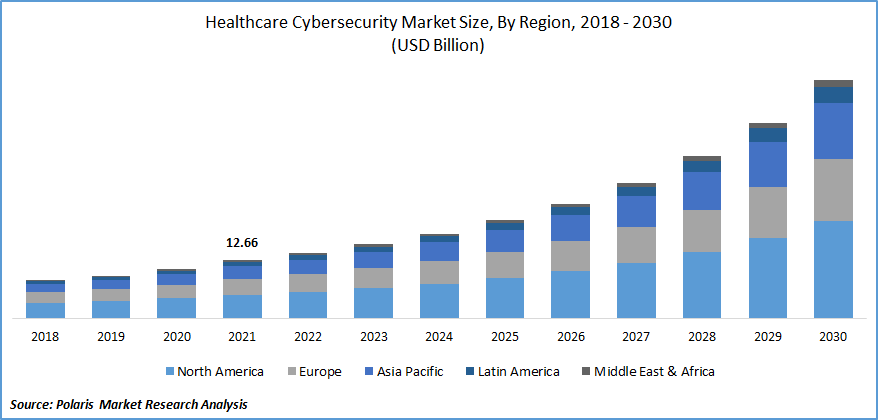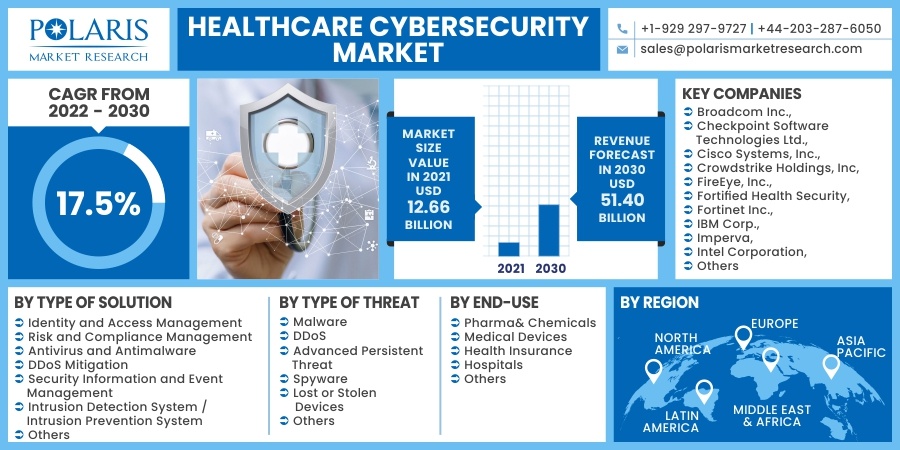
Healthcare Cybersecurity Market Share, Size, Trends, Industry Analysis Report, By Type of Solution; By Type of Threat (Malware, DDoS, Advanced Persistent Threat, Spyware, Lost or Stolen Devices, Others), By End-Use (Pharma & Chemicals, Medical Devices, Health Insurance, Hospitals, Others), By Region; Segment Forecast, 2022 - 2030
- Published Date:Jan-2022
- Pages: 115
- Format: PDF
- Report ID: PM2162
- Base Year: 2021
- Historical Data: 2018 - 2020
Report Outlook
The global healthcare cybersecurity market was valued at USD 12.66 billion in 2021 and is expected to grow at a CAGR of 17.5% during the forecast period. The growth in the market is being driven by the rise in the number of cyber-attacks and the increase in the adoption of mobile device applications and platforms.
 Know more about this report: request for sample pages
Know more about this report: request for sample pages
According to the Center for Strategic & International Studies, in September 2021, the U.S. Cybersecurity and Infrastructure Security Agency (CISA) issued a warning about the rising usage of Conti ransomware in over 400 attacks against the U.S. and international organizations. The warning follows ransomware cyber-attacks on two major farming organizations, Crystal Valley and New Cooperative, in which the hacker demanded USD 5.9 million in ransom.
Besides, the Health Service Executive (HSE), Ireland's National Health Service, was hit by ransomware in May 2021. Government officials shut down the HSE system after the attack was discovered. The attackers employed the Conti ransomware-as-a-service (RaaS), operated by a Russian-based cybercrime group. In Addition, in September 2020, The FBI and CISA reported that Iranian hackers have been targeting U.S. organizations in the I.T., government, healthcare, banking, and media sectors by exploiting publicly known vulnerabilities. Thus, the various cyber-attacks observed in the medical sector across the globe have led to an increase in the market demand for cybersecurity systems in healthcare.
Furthermore, due to the rise in cyber-attacks as a result of COVID-19, the market demand for cybersecurity has risen. Because more patients use remote care, hacking patients' medical devices has become a regular cyberattack during the COVID-19 epidemic. The temporary medical facilities used to treat people infected with the new coronavirus have increased the number of vulnerabilities available to hackers. The Covid-19 vaccine-scheduling website for the Italian province of Lazio was temporarily stopped in August 2021 due to a cyberattack. Several days following the attack, new vaccination appointments could not be made.

Know more about this report: request for sample pages
Industry Dynamics
Growth Drivers
Various causes such as a rise in cybercrime, a growth in the healthcare sector's budget, and increased knowledge about cybersecurity in medical fields have contributed to the healthcare cybersecurity market's significant advances during the previous few decades. So, the healthcare cybersecurity market is predicted to develop over the forecast period.
For instance, according to the American Optometric Association, the medical business is anticipated to be hit by 2 to 3 times as many cyberattacks as other industries between 2017 and 2020. Furthermore, ransomware cyberattacks on health care are expected to quadruple and quintuple by 2021. Cyber-attacks on manufacturing and utility sectors increased fivefold in the first quarter of 2021 compared to the same period last year, while cyberattacks on retailers more than doubled.
The medical industry had the most breaches (162), but these incidents were down 7% from the previous year. The technology sector scored highest in terms of the number of people affected, with 36.6 million, followed by professional services (20.1 million), financial services (9.7 million), and healthcare (9.1 million). Thus, the market demand for cyber security in healthcare has increased as the adoption of advanced healthcare technologies has risen.
Moreover, various government measures to secure personal information are ongoing worldwide, significantly enhancing the healthcare cybersecurity market. Security is a must for all healthcare businesses, including hospitals, clinics, and pharmaceutical corporations, worldwide. Another crucial driving element in the healthcare cyber security market is the increased internet usage and devices in the business. Because of the COVID 19 pandemic, remote access devices were employed more frequently.
Report Segmentation
The market is primarily segmented based on type of solution, type of threat, end-use, and region.
|
By Type of Solution |
By Type of Threat |
By End-use |
By Region |
|
|
|
|
Know more about this report: request for sample pages
Insight by Type of Threat
Based on the type of threat segment, the malware segment dominated the global market in 2021 and is expected to retain its dominance in the foreseen period. In the healthcare industry, there are several cybersecurity challenges. Ransomware is software that infects computers and encrypts data until a ransom is paid.
Critical processes in the healthcare business are hindered or rendered wholly inoperable when this happens. Besides, Malware that compromises system integrity and patient privacy and distributed denial of service (DDoS) attacks that make it difficult for doctors to provide effective patient care are among the threats.
Geographic Overview
In terms of geography, North America had the highest market share in 2021. The market for the North American region is anticipated to grow significantly as a result of the presence of several prominent players in the area, which are focusing on the delivery of advanced solutions for all the industries in the region. In September 2021, the University of Minnesota announced the establishment of a new center to ensure that medical devices are safe and secure from cyberattacks.
After organizations of the medical device manufacturing industry requested a collaborative hub to improve device security discovery, outreach, and workforce training, the Center for Medical Device Cybersecurity (CMDC) was formed CMDC will promote university-industry-government collaborations to generate new education and training, technology, and research to combat possible risks to medical device cybersecurity.
Besides, the increased risk of cyberattacks has sparked a surge in interest in cybersecurity in the United States. Cybercriminals are increasingly focusing on IoT by exposing vulnerable attack surfaces. Furthermore, new cyberattack vulnerabilities emerge as the number of connected devices grows. Moreover, Asia-Pacific is expected to witness a high CAGR in the global market in 2021. The region is growing due to significant players' technological advancements and launches of advanced security systems for healthcare during the forecast period.
In June 2021, Medical Director, an Australian software business, released its latest cybersecurity solution for healthcare organizations. It includes an initial security assessment to determine a system's vulnerability to internet hacking and plug-in detection prevention equipment to prevent possible attacks and 24/7 cybersecurity operations center monitoring.
Competitive Insight
Some of the major market players operating in the healthcare cybersecurity market include Broadcom Inc., Checkpoint Software Technologies Ltd., Cisco Systems, Inc., Crowdstrike Holdings, Inc, FireEye, Inc., Fortified Health Security, Fortinet Inc., IBM Corp., Imperva, Intel Corporation, Juniper Networks, Inc., Kaspersky Lab, Lockheed Martin Corp, LogRhythm, Inc., McAfee LLC, Medigate, Northrop Grumman Corporation, NortonLifeLock Inc., Palo Alto Networks, Sensato Cybersecurity Solutions, Sophos Ltd., Symantec Corporation, and Trend Micro Inc.
Healthcare Cybersecurity Market Report Scope
|
Report Attributes |
Details |
|
Market size value in 2021 |
USD 12.66 billion |
|
Revenue forecast in 2030 |
USD 51.40 billion |
|
CAGR |
17.5% from 2022 - 2030 |
|
Base year |
2021 |
|
Historical data |
2018 - 2020 |
|
Forecast period |
2022 - 2030 |
|
Quantitative units |
Revenue in USD million/billion and CAGR from 2022 to 2030 |
|
Segments covered |
By Type of Solution, By Type of Threat, By End-Use, By Region |
|
Regional scope |
North America, Europe, Asia Pacific, Latin America, Middle East & Africa |
|
Key Companies |
Broadcom Inc., Checkpoint Software Technologies Ltd., Cisco Systems, Inc., Crowdstrike Holdings, Inc, FireEye, Inc., Fortified Health Security, Fortinet Inc., IBM Corp., Imperva, Intel Corporation, Juniper Networks, Inc., Kaspersky Lab, Lockheed Martin Corp, LogRhythm, Inc., McAfee LLC, Medigate, Northrop Grumman Corporation, NortonLifeLock Inc., Palo Alto Networks, Sensato Cybersecurity Solutions, Sophos Ltd., Symantec Corporation, and Trend Micro Inc. |
